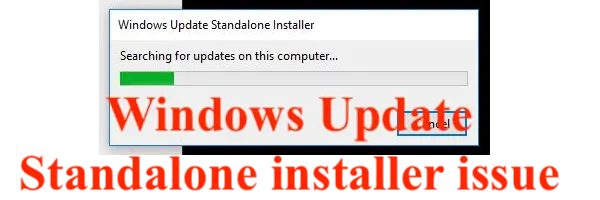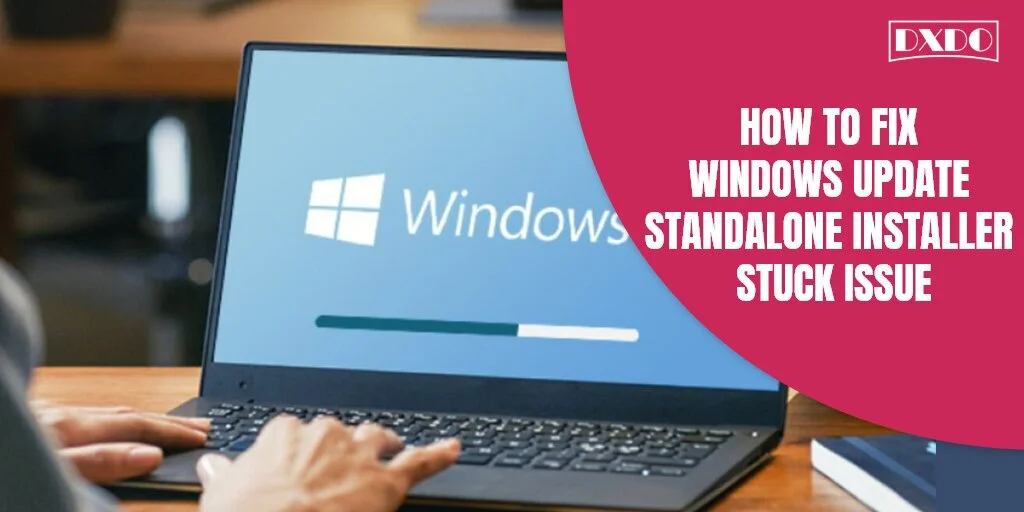Users who have experienced the “Windows Update Standalone Installer Stuck at looking for Updates” issue have claimed that the search takes a long time (many hours) or gets stuck permanently. Another sign of this problem is the Svchost.exe process using a lot of CPU and RAM. This problem first appeared in the second quarter of 2016, and it has been proven to affect Windows Vista, Windows 7, and Windows 8.
This behavior is most common following a fresh OS installation or an update from a previous Windows version. Microsoft hasn’t yet given a “one-size-fits-all” solution to help end-users dealing with this issue.
Check if Your Windows Update Standalone Installer is Stuck?
Before you try any of the above solutions, check sure your machine is indeed experiencing this problem. The updating component can malfunction for a variety of reasons.

Follow the instructions below to discover if your computer is experiencing any of the symptoms listed below:
- Open Task Manager (Ctrl + Shift + Esc), go to the Processes tab, and select Show processes from all users from the Show processes from all users drop-down menu.
- To highlight the Wuaserv service, go to the Services tab and click on it. Then select Go to Process from the context menu by right-clicking on it. The Process tab in Task Manager should automatically reopen and highlight the Svchost.exe process associated with Windows Updates.
- Monitor Svchost.exe for a while and see how it operates. If you notice that the process uses a lot of CPU and RAM (about 200 MB), there’s a good probability that your machine is experiencing this problem. As a result, the strategies listed below should help you apply the missing updates while also reducing resource utilization.
Methods to Fix Windows Update Standalone Installer Stuck Issue?
If you’ve established that your computer is experiencing the same issues, you can move on to the possible solutions listed below. Please use the two ways in the order listed until you find a solution that works for you.
1. Disable Automatic Updates
If you’re running Windows 7 or Windows 8, you can try disabling automatic Windows updates and then running the Standalone Installer to fix the “Windows Update Standalone Installer not working” problem. On Windows 7, here’s how to accomplish it:
Step 1: In the Start menu, type Window update, then click the first result to open it.
Step 2: Click Change settings in the left panel.
Step 3: Under the Important Updates section, select Never check for updates from the drop-down option (not recommended). Then, to save the changes, click OK.
Then restart your computer and run the Standalone Update Installer to see if any improvements have been made.
2. Updating via WSUS Offline Updater
You can also use WSUS Offline Updater to fix the “Windows Update Standalone Installer stopped” issue, which is a simple open-source software utility for Windows 7/8 that automatically downloads missing updates from the Microsoft server.
Step 1: Download WSUS Offline Updater, making sure to get the most recent version of the utility.
Step 2: Run the wsusoffline.zip file after extracting it.
Step 3: Check the boxes for Verify downloaded updates, C++ Runtime Libraries, and Net Frameworks.
Step 4: To download the missing updates, click Start. Open the Client folder after returning to the wsusoffline folder.
Step 5: Open Updateinstaller.exe by double-clicking it. Then click Start and tick the option for Update C++ Runtime Libraries.
All of the uninstalled updates from the previous step will be installed. The installation of an update can take anywhere from a few minutes to many hours
3. Run the Windows Update Troubleshooter
Windows Update Troubleshooter is a built-in utility that is designed to help common users fix windows update issues. The fastest way to fix the “Windows Standalone Installer Stuck” issue on Windows 10 is to run the Windows Update Troubleshooter.
Step 1: You can now fix it by following the steps outlined below:
Step 2: In the Search box, type Settings to open the Settings application.
Step 3: Go to the Troubleshoot area and then to the right panel, pick Windows Update. Then, under the Troubleshooter tab, click Run.
Step 4: After the scanning process has detected any existing issues, click Apply this update.
To complete the repair process, follow the on-screen directions.
Restart your computer and examine whether the “Windows Update Standalone Installer is continually searching for updates” problem still occurs. If this solution fails to resolve the issue on Windows 10, you can move on to the next step.
4. Download Most Recent SSU
If the troubleshooter fails to locate and resolve the issue, go to the Microsoft official website and download and install the most recent SSU (Servicing Stack Update). Make sure you are using 32-bit or 64-bit Windows before downloading the SSU. After that, you can download the most recent SSU by following the instructions below:
Step 1: Go to the SSU download page. SSU updates are available in 32-bit and 64-bit versions.
Step 2: To run the SSU, double-click it.
Step 3: If everything is in order, it will search your PC for pending updates and prompt you to install them. All you have to do now is click Yes.
Restart your computer and check for any remaining uninstalled updates.
5. Download Most Recent Kb
If the latest SSU does not resolve the problem, you can try downloading the most recent KB from the Microsoft Official Website. Follow the steps below to get started:
Step 1: To open the Settings app, hold down the Windows key and the ‘I’ key Step 2: Select Update & Security from the Update & Security section.
Step 3: In the right panel, select View update history under the Windows Update section.
Step 4: Next, locate the most recent KB for your Windows 10 version and copy the KB code.
Step 5: Search for the KB code on the Microsoft update website. It is available for download for Windows.
Once the download is complete, open it and install it. Then you can see if the “Windows Standalone Installer not working” problem has been resolved.
6. Fix Windows File Corruption
One of the reasons why Windows Update Standalone Installer is stuck searching for updates could be a corrupted Windows system file. In this case, you can use two command-line applications to repair your Windows system files: SFC (System File Checker) and DISM (Deployment Image Servicing and Management).
SFC is a program that scans your system for corrupted files and repairs them. It will examine your system thoroughly and repair any faulty files. However, if SFC is unable to locate the faults, the DISM can assist you.
Here’s how to fix corrupt system files with SFC:
Step 1: In the search field, type Command Prompt and click Run as administrator.
Step 2: Press Enter after typing the following instruction.
You can review the scan findings to see if there are any issues when the verification is done 100 percent whether any issues are discovered, run the SFC command numerous times to see if they can be fixed.
Then read this post: Repair Windows 10 Image with DISM and Other Useful Tips for DISM to learn how to utilize DISM to fix broken system files. The “Windows Update Standalone Installer stalled at searching for updates” issue should be resolved after utilizing these approaches, regardless of whether you’re using Windows 7, 8, or 10.
Final Words
To summarise, this article explains how to tell if your Windows Update Standalone Installer is stuck searching for updates and how to resolve the problem. If you run into this problem, you can attempt the solutions listed above.














